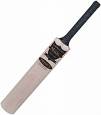
 |
| Index | ||||||
|
Bat, willow  A cricket bat must be no longer than 38 inches (96.5 cm) or wider than 4 ¼ inches (10.8 cm). There is no specified maximum weight of a bat The bat handle is mainly comprised of cane, for light weight and springiness, while the blade must be made entirely of wood. The wood most commonly used is specially-grown willow, which is both tough and lightweight, the finest examples of which are Salix alba coerulea, trees that can grow up to c.90 feet (c.30 m) high, usually felled when between 15 and 25 years old Because cricket bats are increasingly expensive to replace, the Laws permit the blade to be repaired with covering material to bind up cracks in the wood. Any such repair or covering - which is usually in the form of specialised sticky tape - must not be thicker than 1/16th inch and must not itself be capable of causing damage to the ball During play, the hand, hands, glove or gloves of the striker are regarded as part of the bat for as long as they are in contact with it. So, if a striker is hit on the glove while holding the bat by a fair delivery and that ball is subsequently caught he should be given out Caught on appeal. | ||||||